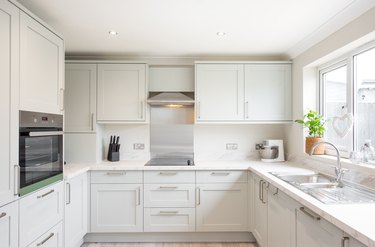
Custom made cabinets are built to fit the location they are installed in. They might be simple storage cabinets in the basement, a new bathroom vanity or a complete set of kitchen cabinets. Today, most cabinets are made of plywood or particle board. Building your own cabinets requires knowing a little bit about plywood sizes and grades along with the actual woodworking skills you put to use in making them.
Plywood Thickness
Video of the Day
Plywood is sold in 4 x 8 foot sheets in a variety of thicknesses. Purchase plywood based on face grades and thickness to suit your purpose. In the case of cabinets such as vanities, kitchen cabinets and similar applications, acceptable grades and thickness are dependent on where the sheet of plywood will be used.
Video of the Day
Make cabinet sides of 3/4, 5/8 or 1/2-inch plywood. Choose 3/4-inch or 5/8-inch to use European style hinges. Selecting 1/2-inch plywood for cabinets with face frames will save money and weight.
Use 1/4-inch plywood for the cabinet back unless it will support the weight of the cabinet, in which case 1/2 inch is a better choice. Select 1/2-inch plywood for drawer sides, fronts and backs, but 1/4 inch is suitable for drawer bottoms.
Plain front plywood doors are rare, but they can be made from 3/8-inch plywood. Simple frame and panel doors can have 1/4-inch plywood panels inserted into the frames.
Plywood Grades
Plywood has two faces, a front and a back, and is graded according to appearance and veneer matching quality. Four face grades are A, B, C and D for cabinet grades where A is the best and D is the least desirable. The back faces are graded from 1 to 4, with 1 being the most desirable and 4 the least.
A1, A2, B1 and B2 are quality grades used for applications in which both sides of the sheet will be visible, such a kitchen cabinet with exposed sides. A3, B3 and C3 would be good where only one side will be seen, such as a cabinet with drawers. A4, B4 and C4 grades have only one good side, so used them for cabinet backs, drawer bottoms and similar applications.
Understanding Thickness
Plywood panels are sold in home centers using fractions of an inch. Measuring carefully, we might find 1/2-inch plywood is only 31/64 thick, a full 1/32 of an inch thinner than expected. Cabinet manufacturers specify a plus zero, minus 1.2 mm tolerance. It's easier to deal with an undersized piece of plywood than an oversize one.
Check the face marking on a sheet of plywood sold as a fraction of an inch thickness, and you might be surprised to find it has a metric specification. Many plywood manufacturers today produce plywood that is measured in millimeters rather than inches.
Select plywood for cabinet building depending on how it will be used and whether it will be seen. Plywood is the choice of woodworkers who build fine quality cabinets. Choosing the correct thickness and grade is the first step in the final build plan.